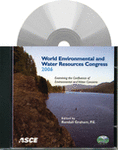Evaluation of Retention Pond and Constructed Wetland BMPs for Treating Particulate-Bound Heavy Metals in Urban Stormwater Runoff
Publication: World Environmental and Water Resource Congress 2006: Examining the Confluence of Environmental and Water Concerns
Abstract
The sources of heavy metals in urban stormwater runoff are numerous (e.g., highways, road surfaces, roofs) and the release of metals into the environment is governed by several complex mechanisms. Heavy metals in stormwater are associated with suspended particulate materials that vary from coarse (>75 micrometer) and fine particulates (<75 to 1 micrometer), to colloids (<1 micrometer). Stormwater runoff investigations increasingly focus on evaluating quality and the effectiveness of adopting best management practices (BMPs) to minimize pollutant input, including heavy metals, to receiving waters. Heavy metals in stormwater are primarily removed by sedimentation in BMPs such as retention ponds and constructed wetlands; these sediments may be toxic to benthic invertebrates and aquatic microorganisms. Information on heavy metals-particulate association is therefore a fundamental requirement prior to using wetland and pond BMPs for treatability studies. Research is being conducted at the U.S. EPA's Urban Watershed Research Facility in Edison, NJ to evaluate the effectiveness of retention pond and constructed wetland BMP mesocosms to remove particulate-bound heavy metals from roof and parking-lot stormwater runoff. The research objectives include: (1) investigating the association of selected heavy metals (Al, Cr, Cu, Fe, Mn, Pb, and Zn) with fine particulates (20 to 0.4 micrometer) in stormwater runoff, (2) evaluating the relative removal of particulate-bound as well as dissolved heavy metals in retention ponds and cattail wetland mesocosms, and (3) investigating the solid-phase chemical associations of heavy metals in cattail wetland sediments by selective sequential extraction procedures and thereby assessing the potential for sediment toxicity and heavy metal bioavailability. This investigation comprises the study of eight separate storm events; three sampling events have been completed to date. Preliminary results showed that Fe and Al were primarily particulate-bound (>20 micrometer); Mn was mostly soluble while Cu and Zn were primarily associated with fine particulates (10 – 1 micrometer) and in the dissolved fraction (<0.4 micrometer) in stormwater runoff. Also, the retention pond and cattail wetland mesocosms were effective in attenuating Cu, Zn, and Al. Preliminary results are also presented for the chemical fractionation of cattail wetland sediments.
Get full access to this chapter
View all available purchase options and get full access to this chapter.
Information & Authors
Information
Published In
Copyright
© 2006 American Society of Civil Engineers.
History
Published online: Apr 26, 2012
ASCE Technical Topics:
- Best Management Practices (BMPs)
- Chemical compounds
- Chemical elements
- Chemicals
- Chemistry
- Environmental engineering
- Heavy metals
- Hydrologic engineering
- Hydrology
- Infrastructure
- Retention basins
- River engineering
- River systems
- Runoff
- Sediment
- Stilling basins
- Stormwater management
- Urban and regional development
- Urban areas
- Water and water resources
- Water treatment
- Wetlands (fresh water)
Authors
Metrics & Citations
Metrics
Citations
Download citation
If you have the appropriate software installed, you can download article citation data to the citation manager of your choice. Simply select your manager software from the list below and click Download.
